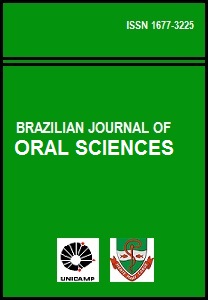Abstract
This investigation sought to analyze 3 disinfectants: 0.5% chlorhexidine, 2% glutaraldehyde, and 1% sodium hypochlorite after immersion of irreversible hydrocolloid and zinc oxide-eugenol paste impressions. Changes detected in the solutions could suggest alterations in the dental impressions, compromising their quality and negatively influencing treatment outcome. Forty-five irreversible hydrocolloid impressions (Jeltrate) made in aluminum stock impression trays (AG) as well as 45 irreversible hydrocolloid and 45 zinc oxide-eugenol paste (Horus) impressions made in auto polymerizing acrylic resin (AAR) trays (VipiFlash) were immediately immersed in 200mL of 0.5% chlorhexidine (Labfa), 2% glutaraldehyde (Glutaron II), or 1% sodium hypochlorite ( Miyako) solutions for 10, 30, and 60 minutes. After immersion the solutions were analyzed by visible ultraviolet spectroscopy and turbidimetry to verify possible alterations. Turbidimetry (registered in nephelometric turbidity units -NTU) results were subjected to Kruskal-Wallis and Mann-Whitney tests for statistical analysis (á=.05). An increase of absorption levels of all disinfectants was found after immersion of irreversible hydrocolloid impressions. This increase was proportional to time of immersion and absorption was higher for 0.5% chlorhexidine for the 3 time periods analyzed. Only 1% sodium hypochlorite presented statistically significant alterations after immersion of zinc oxideeugenol paste impressions.References
Rowe AH, Forest JO. Dental impressions: the probability of contamination and a method of disinfection. Br Dent J. 1978; 145: 184-6.
Setcos JC; Peng L; Palenik CJ. The effect of disinfection procedures on an alginate impression material [abstract 582]. J Dent Res. 1984; 63: 235.
Bergman B, Bergman M, Olsson S. Alginate impression materials, dimensional stability and surface details sharpness following treatment with disinfectant solutions. Swed Dent J. 1985; 9: 255-62.
Minagi, S, Fukushima K, Maeda N, Satomi K, Ohkawa S, Akagawa Y et al. Disinfection method for impression materials: freedom from fear of hepatitis B and acquired immunodeficiency syndrome. J Prosthet Dent. 1986; 56: 451-4.
Durr DP, Novak EV. Dimensional stability of alginate impressions immersed in disinfecting solutions. ASDC J Dent Child. 1987; 54: 45-8.
Rueggeberg FA, Beall FE, Kelly MT, Schuster GS. Sodium hypochlorite disinfection of irreversible hydrocolloid impression material. J Prosthet Dent. 1992; 67: 628-31.
Tan HK, Wolfaardt JF, Hooper PM, Busby B. Effects of disinfecting irreversible hydrocolloid impressions on the resultant gypsum casts. Part I – Surface quality. J Prosthet Dent. 1993; 69: 250-7.
Tan HK, Hooper PM, Buttar IA, Wolfaardt JF. Effects of disinfecting irreversible hydrocolloid impressions on the resultant gypsum casts. Part II – Dimensional changes. J Prosthet Dent. 1993; 70: 532-7.
Hilton TH, Schwartz RS, Bradley Jr DV. Immersion disinfection of irreversible hydrocolloid impressions. Part 2: Effects on gypsum casts. Int J Prosthodont. 1994; 7: 424-33.
Johnson GH, Chellis KD, Gordon GE, Lepe X. Dimensional stability and detail reproduction of irreversible hydrocolloid and elastomeric impressions disinfected by immersion. J Prosthet Dent. 1998; 79: 446-53.
Herrera SP, Merchant VA. Dimensional stability of dental impressions after immersion disinfection. J Am Dent Assoc. 1986; 113: 419-22.
Bergman B. Disinfection of prosthodontic impression materials: a literature review. Int J Prosthodont. 1989; 2: 537-42.
Blair FM, Wassell RW. A survey of the methods of disinfection of dental impressions used in dental hospitals in the United Kingdom. Br Dent J. 1996; 180: 369-75.
American dental association council on scientific affairs and American dental association council on dental practice: Infection control recommendations for the dental office and the dental laboratory. J Am Dent Assoc. 1996; 127: 672-80.
American dental association council on dental therapeutics; council on prosthetic services and dental laboratory relations: Guidelines for infection control in the dental office and commercial laboratory. J Am Dent Assoc. 1985; 110: 969-72.
American dental association council on dental materials and equipment: Disinfection of impressions. J Am Dent Assoc. 1991; 122: 110.
Merchant VA, Stone CR, Badr SE, Gleason MJ. Dimensional stability of disinfected zinc oxide eugenol impressions [Abstract]. J Dent Res. 1990; 69: 304.
Orchin M, Jaffe HH. Symmetry, orbitals and spectra (S. O. S.). New York: Wiley-Interscience; 1971. p. 1-20.
Colthup NB, Wimberley DSE. Introduction to infrared and raman spectroscopy. New York: Academic Press International; 1964. p. 1-35.
The Brazilian Journal of Oral Sciences uses the Creative Commons license (CC), thus preserving the integrity of the articles in an open access environment.

